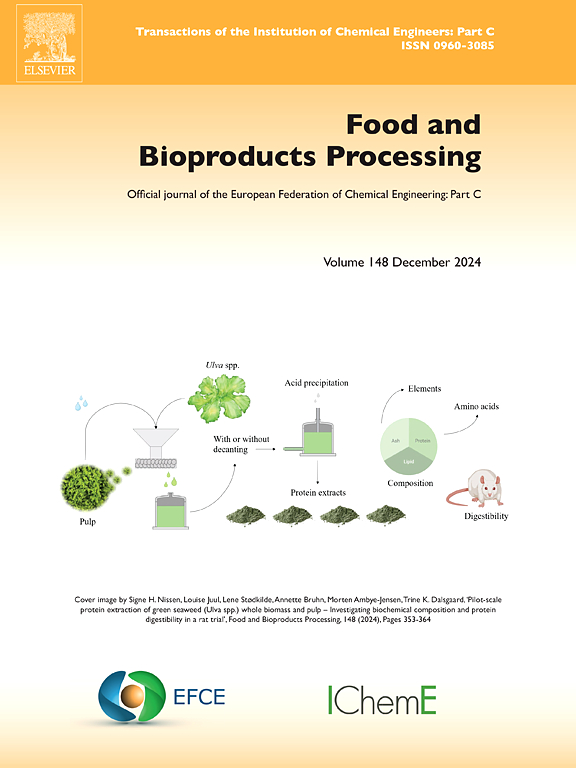高粱全株酒糟生产抗氧化肽的技术经济分析
IF 3.5
2区 农林科学
Q2 BIOTECHNOLOGY & APPLIED MICROBIOLOGY
引用次数: 0
摘要
谷物高粱为乙醇生产提供了一个可行的生物质选择,为解决由化石燃料使用引起的全球变暖的紧迫问题提供了一种手段。然而,后高粱生物乙醇生产产生了大量新鲜高粱秸秆作为废物,这给处理和处置带来了重大挑战。这种富含蛋白质的蒸馏液有望成为生产抗氧化肽的来源。本研究的目的是评价通过酶水解将高粱全醪转化为抗氧化肽的经济可行性。该工艺设计需要酶水解,然后是分离和干燥过程,以产生抗氧化肽产品和高纤维副产品。研究了三种不同的情况,每种情况都考虑了不同的蛋白酶来源和酶水解条件:分别是Neutrase, Alcalase和Flavourzyme。假设加工设施毗邻高粱生物乙醇工厂,每小时产生93.7公吨的新鲜高粱蒸馏液。方案1、方案2和方案3的总资本投资(TCI)分别为60.8 万美元、600.9 万美元和59.4 万美元。在情景1至情景3中,抗氧化肽(MSPP)的最低销售价格分别为1048美元/吨、1098美元/吨和2578美元/吨。这些值表明,与蛋白质和人工抗氧化剂产品的市场价格相比,加工的经济可行性。此外,还进行了经济敏感性分析,以确定影响该工艺经济性能的关键参数。研究发现,改进加工参数和减少经济变量可以显著降低最低销售价格至762美元/吨。本研究提供了从整株高粱蒸馏液中生产抗氧化肽的基本经济指标,为其他谷物蒸馏液或富含蛋白质的农业废弃物的处理提供了有价值的见解。本文章由计算机程序翻译,如有差异,请以英文原文为准。
Techno-economic analysis of producing antioxidant peptides from whole sorghum stillage
Grain sorghum presents a viable biomass option for ethanol production, offering a means to address the pressing issue of global warming stemming from fossil fuel usage. However, post-sorghum bioethanol production generates a substantial volume of fresh sorghum stillage as waste, which poses significant handling and disposal challenges. This stillage, rich in protein content, holds promise as a source for producing antioxidant peptides. The aim of this study was to evaluate the economic feasibility of converting whole sorghum stillage into antioxidant peptides through enzymatic hydrolysis. The process design entails enzymatic hydrolysis, followed by separation and drying processes to yield both an antioxidant peptide product and a high-fiber co-product. Three distinct scenarios were examined, and each considered different protease sources and enzymatic hydrolysis conditions: Neutrase, Alcalase, and Flavourzyme, respectively. It is assumed that the processing facility is adjacent to a sorghum bioethanol plant, generating 93.7 metric tons (MT) of fresh sorghum stillage per hour. Total capital investments (TCI) were estimated at 60.8 M USD, 60.9 M USD, and 59.4 M USD for scenarios 1, 2, and 3, respectively. The minimum selling price of antioxidant peptides (MSPP) was determined to be 1048 USD/MT, 1098 USD/MT, and 2578 USD/MT for scenarios 1 through 3, respectively. These values indicate the economic viability of the processing compared to market prices of protein and artificial antioxidant products. Furthermore, an economic sensitivity analysis was conducted to identify critical parameters influencing the economic performance of the process. It was found that implementing advancements in processing parameters and reductions in economic variables could significantly decrease the minimum selling price to 762 USD/MT. This study furnishes essential economic metrics for antioxidant peptide production from whole sorghum stillage, offering valuable insights applicable to the treatment of other grain stillage or protein-rich agricultural waste.
求助全文
通过发布文献求助,成功后即可免费获取论文全文。
去求助
来源期刊

Food and Bioproducts Processing
工程技术-工程:化工
CiteScore
9.70
自引率
4.30%
发文量
115
审稿时长
24 days
期刊介绍:
Official Journal of the European Federation of Chemical Engineering:
Part C
FBP aims to be the principal international journal for publication of high quality, original papers in the branches of engineering and science dedicated to the safe processing of biological products. It is the only journal to exploit the synergy between biotechnology, bioprocessing and food engineering.
Papers showing how research results can be used in engineering design, and accounts of experimental or theoretical research work bringing new perspectives to established principles, highlighting unsolved problems or indicating directions for future research, are particularly welcome. Contributions that deal with new developments in equipment or processes and that can be given quantitative expression are encouraged. The journal is especially interested in papers that extend the boundaries of food and bioproducts processing.
The journal has a strong emphasis on the interface between engineering and food or bioproducts. Papers that are not likely to be published are those:
• Primarily concerned with food formulation
• That use experimental design techniques to obtain response surfaces but gain little insight from them
• That are empirical and ignore established mechanistic models, e.g., empirical drying curves
• That are primarily concerned about sensory evaluation and colour
• Concern the extraction, encapsulation and/or antioxidant activity of a specific biological material without providing insight that could be applied to a similar but different material,
• Containing only chemical analyses of biological materials.
 求助内容:
求助内容: 应助结果提醒方式:
应助结果提醒方式:


